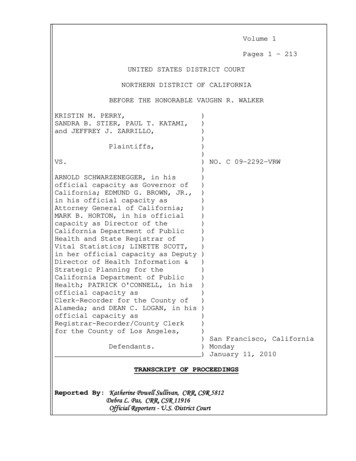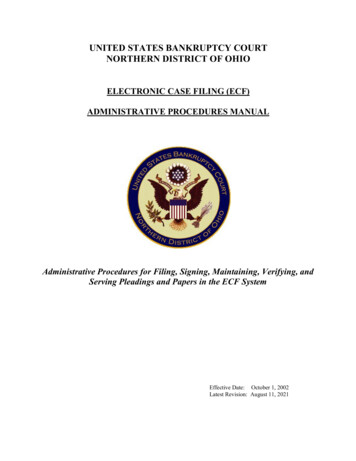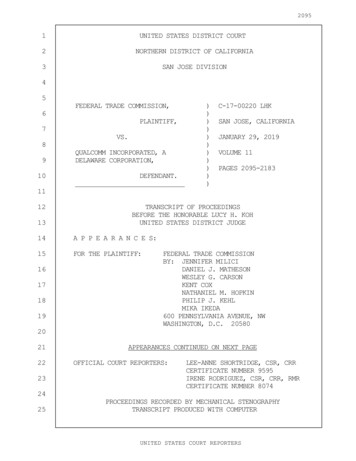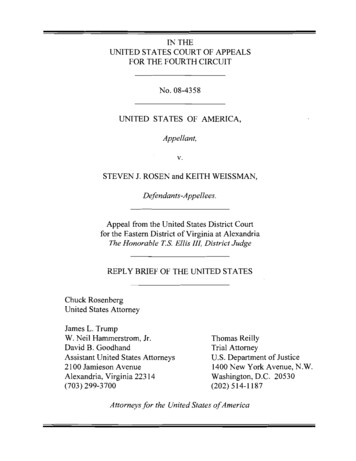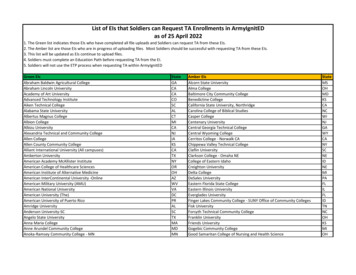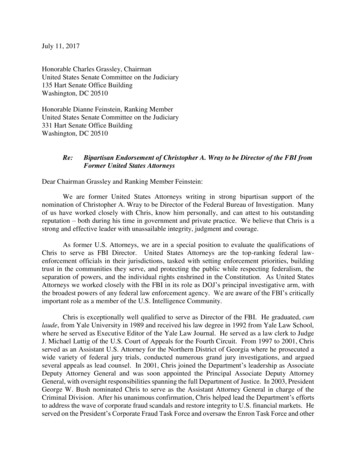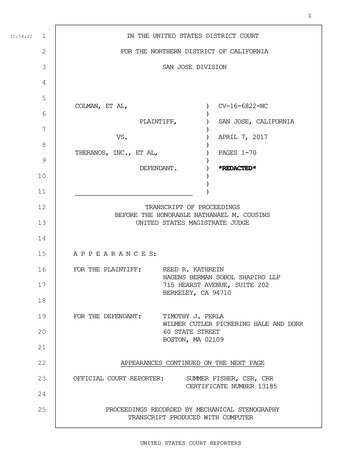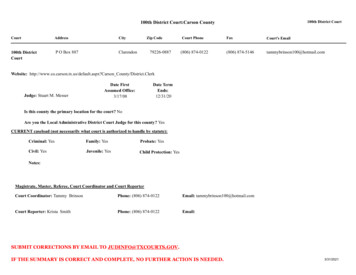
Transcription
Chapman v. Spartan Offshore Drilling, LLC et alDoc. 32UNITED STATES DISTRICT COURTEASTERN DISTRICT OF LOUISIANAGEORGE L. CHAPMANCIVIL ACTIONVS.NO. 15-CV-994SPARTAN OFFSHORE DRILLING,LLC AND MARINE TRANSPORTATIONSERVICES, INC.SECTION “B”(5)ORDER AND REASONS1Before the Court is defendant, Spartan Offshore Drilling,LLC’s (“Spartan”) motion for partial summary judgment on thegrounds that plaintiff lacks a cause of action for claims ofmaintenance and cure. Rec. Doc. 19. Plaintiff George L. Chapman(“Chapman”) opposes the motion. Rec Doc. 22. Defendant has fileda reply (Rec. Doc. 26) and supplemental memorandum (Rec. Doc. 30)in support of its motion.Having considered the memoranda of counsel, the record, andthe applicable law,IT IS ORDERED that the motion is GRANTED.I.BACKGROUNDThis action arises under the Jones Act, 46 U.S.C. § 30104,and the General Maritime Laws. Rec. Doc. 1 at 2. Chapman wasemployed by Spartan as a Jones Act seaman aboard the M/V SPARTAN208 in September 2014. Id.John D’Avello, a third year student at Tulane University Law School,assisted in drafting this order.11Dockets.Justia.com
A. Factual BackgroundThe undisputed facts reveal that Chapman initially appliedfor a position with Spartan in June 2013 and was hired. Rec. Doc.19-7 at 2–3. He was laid off in November 2013 due to a workforcereduction but reapplied and was rehired as a roustabout in January2014. Id. As a condition to initial employment, Spartan ntentranceexamination (“entrance exam”) and be cleared by a physician. Rec.Doc. 19-2 at 6–7; Rec. Doc. 19-7 at 3–4. Upon his second hiringSpartan required that Chapman review and provide any rphysicalexamination. Id. The entrance exam is comprised of a list ofquestions about a potential employee’s medical history. Rec. Doc.19-7. The prospective employee must certify that any informationprovided is true and correct, and acknowledge that failure totruthfully answer any question could result in the denial of aright to maintenance and cure benefits. Id. at 19.The entrance exam requires a prospective employee to indicateif he or she has experienced a variety of medical issues. Chapmancompleted his first entrance exam on June 17, 2013. Rec. Doc. 191 at 3; Rec. Doc. 22-1 at 1. He indicated by checking the box for“Yes” and providing a brief explanation that he had previously hada shoulder spur removed, had broken his left arm, and had pulleda muscle in his lower back. Id. at 6–8, 12–15. Chapman checked2
“No” for all other relevant questions, including if he had everhad surgery, lost time from work, had work activities restrictedby a doctor, was taking any medication or was subject to anymedical treatment. See Id. at 5-15. Chapman signed and dated thefirst entrance exam, certifying that all supplied information wastrue and correct and acknowledging that failure to truthfullyanswer any question could result in denial of maintenance and curebenefits. Id. at 19.It is uncontested that, despite Chapman’s representations onhis first entrance exam, he had in fact complained of and beentreated for lower back problems for the past seven years. OnJanuary 5, 2006, Chapman visited Dr. Sage B. Smith and complainedof lower back pain. Rec. Doc. 19-1 at 1; Rec. Doc. 22-1 at 1. scherniation at L5-S1. Id. On January 17, 2006, Chapman visited Dr.Robert White at the Coastal Neurological Institute and reported adull ache in his lower back that had existed for six to eightyears. Id. Chapman received lumbar epidural steroid injections onthirteen separate occasions over the next seven years. Rec. Doc.19-1 at 2–3; Rec. Doc. 22-1 at 1–2. Chapman or his wife also calledDr. Smith on twelve separate occasions from August 17, 2006 toJanuary 7, 2010, to request pain medication for his back. Id. Ona June 27, 2012, visit with Dr. William Smith, Chapman reportedmissing time from work due to back pain; Dr. Smith subsequently3
restricted Chapman from working for an additional two weeks. Id.On July 23, 2012, Chapman underwent a lumbar MRI which revealed adisc herniation at the L4-5 level of the spine. Id. Chapmandisputes whether Dr. Smith discussed the possibility of backsurgery with him on this date. Id. Chapman received four lumbarepidural injections between June 2012 and May 2013, including oneon May 17, 2013. Id.Spartan’s physical examination of Chapman was conducted byDr. Kirthland D. Swan (“Dr. Swan”)on June 17, 2013—just one monthafter he had last received a lumbar epidural injection. Rec. Doc.19-1 at 4; Rec. Doc. 22-1 at 2. In response to a direct question,Chapman denied having any history of disc or other problems withhis back. Id. Chapman was also examined by Dr. J. Lee Leonard(“Leonard”) on that day. Id. Chapman’s deposition states that hediscussed his history of back issues with Dr. Leonard and that thetwo went over the results of an x-ray examination showing Chapman’sdisc issue. Rec. Doc. 22-6 at 5. Dr. Leonard testified no suchmedical history was discussed, and that he would have noted anysuch discussion and referred Chapman for further MRIs in light ofsuch history. Rec. Doc. 19-10 at 3–4, 9–10. Further, Dr. Leonardstated that if he had known of Chapman’s herniated disc, he alexaminations. Id. at 4-5. Dr. Leonard stated “you can’t see a discon an x-ray.” Id. at 8.4
When Chapman applied for a roustabout position with Spartanon January 20, 2014, he reviewed the entrance exam he previouslycompleted on June 17, 2013, and made no changes to any informationit contained. Rec. Doc. 19-1 at 5; Rec. Doc. 22-1 at 2. Chapmanhad received a lumbar epidural steroid injection in November 2013,which he did not reveal. Id. Dr. Swan conducted another physicalexamination. Id. In response to direct questions from Dr. Swan,Chapman denied ever having been told he had a back disorder orreceiving treatment for his back. Id. He also denied having a discproblem in his back, and denied ever having any problem with hisback except for a pulled muscle that “lasted a week or so” in 2013.Id. Chapman acknowledged in a deposition that he lied to Spartanregarding his past history of back injuries while knowing thatSpartan wanted the information as a prerequisite to hiring. Rec.Doc. 19-8 at 4-5.On September 2, 2014, Chapman reported waking up to a pain inhis back. Rec. Doc. 19-2 at 14. A supervisor at Spartan filed theinitial report that day. Rec. Doc. 19-11 at 3. The report statesChapman experienced pain in his right leg and lower back upongetting out of bed, but could not recall injuring it. Id. Chapmanalso revealed that he had trouble with his back in the past. Id.Subsequently, Chapman recalled injuring his back while unloadinga pipe in the scope of his employment the day before. Rec. Doc. 22at 2. Wilton Landry, Spartan’s Health, Safety, and Environmental5
manager, thereafter made arrangements to remove Chapman from therig so he could seek medical attention. Rec. Doc. 19-11 at 1–2.Spartan provided maintenance and cure for a short period of time.Id. While investigating the reported incident, Spartan securedChapman’s medical records and discovered his prior history of backinjuries. Rec. Doc. 19-2 at 15. Based upon the failure to discloseprior medical history, Spartan terminated maintenance and curepayments and denied approval of the recommended surgery. Id.Chapman sought treatment with Dr. Rand Voorhies, a neurosurgeon,who recommended a lumbar fusion at the L4-5 level. Rec. Doc. 19-2at 15; Rec. Doc. 22 at 3.B. Procedural BackgroundChapman filed this suit on March 31, 2015. Rec. Doc. andsubsequent expenses, as well as punitive damages for arbitraryand/or unreasonable failure to provide maintenance and cure. Rec.Doc. 1 at 3–5. On December 21, 2015, Spartan moved for partialsummary judgment on the issue that plaintiff lacks a cause ofaction for maintenance and cure. Rec. Doc. 19.C. Arguments of the PartiesSpartan argues that Chapman lacks a cause of action formaintenance and cure because he willfully concealed a history of6
lower back treatment that was material to the decision to hire andcausally linked to the injury complained of. Rec. Doc. 19 at inappropriate and urging the Court to either defer or deny themotion, allow timefor Chapmanto obtain affidavits or takediscovery, or issue some other appropriate order. Rec. Doc. 22.Chapman first argues that the motion for partial summary judgmentis premature because discovery is not yet complete. Id. at 1.Chapman urges the Court to allow for three “key” depositions: (1)the treating physician, Dr. Rand Voorhies, regarding the causallink between the allegedly concealed injuries and the ghisallegeddiscussion of back surgery with Chapman prior to employment; and(3) Wilton Landry, regarding his knowledge of Chapman’s priormedical history. Doc. 22 at 1–2. Landry has now been deposed, andasserted he had no previous knowledge of Chapman’s injury andindeed had no knowledge of Chapman at all until he reported hisinjury. Rec. Doc. 28-3 at 3–4.Chapman also asserts that summary judgment is inappropriateon the merits for three reasons. Rec. Doc. 22 at 5–8. First,Chapman asserts Spartan cannot establish concealment of priorinjuries. Id. at 5-7. Second, Chapman argues that even if suchback issues were not disclosed at the time of hiring they wereimmaterial to any hiring decision. Id. at 7. Finally, Chapman7
argues no causal link exists between the prior injuries and thecurrent injury. Id. at 8.II.SUMMARY JUDGMENT STANDARDSummary judgment is appropriate only if “the pleadings,depositions, answers to interrogatories, and admissions on file,together with the affidavits show that there is no genuine issueas to any material fact and the movant is entitled to judgment asa matter of law.” Celotex Corp. v. Catrett, 477 U.S. 317, 322(1986); TIG Ins. Co. v. Sedgwick James, 276 F.3d 754, 749 (5thCir. 2002). A genuine dispute of material fact exists when the“evidence is such that a reasonable jury could return a verdictfor the nonmoving party.” Royal v. CCC & R. Tres Arboles, L.L.C.,736 F.3d 396, 400 (5th Cir. yestablish the nonmoving party’s lack of evidence to support itscase. FED.R.CIV.P. 56(c); Stauffer v. Gearhart, 741 F.3d 574, 582(5th Cir. 2014). Once this burden is met, a party cannot unsubstantialassertions, or ‘only a scintilla of evidence.’ ” Celtic MarineCorp. v. James C. Justice Companies, Inc., 760 F.3d 477, 481 (5thCir. 2014); TIG Ins. Co., 276 F.3d at 759. Rather, the nonmovantmust go beyond the pleadings and use affidavits, herevidencetoestablish the existence of a genuine factual issue. Matsushita8
Elec. Indus. Co. v. Zenith Radio Corp., 475 U.S. 574, 586 (1986).In considering the motion a court must draw all justifiableinferences in favor of the nonmoving party and must not makecredibility determinations or weigh the evidence. TIG Ins. Co.,276 F.3d at 759; Celtic Marine Corp., 760 F.3d at 481.III.JonesActseamanareLAW AND ANALYSISentitledtopowerfulandgenerousremedies under general maritime law due to their close relationshipwith the vessel and the particular hazards of their work; chiefamong these benefits is the right to maintenance and cure. Willisv. McDonough Marine Serv., Civ. A. No. 14–811, 2015 WL 3824366, at*3 (E.D. La. June 18, 2015). Maintenance is a duty imposed upon ashipowner to provide for a seaman who becomes injured during hisservice to the ship. Silmon v. Can Do. II, Inc., 89 F.3d 240, 242(5th Cir. 1996). Maintenance is a subsidence allowance intended tocover the reasonable costs a seaman incurs for his food and lodgingduring the period of his injury. See Guevara v. Mar. OverseasCorp., 59 F.3d 1496, 1499 (5th Cir. 1995), abrogated on othergrounds, Atl. Sounding Co., Inc. v. Townsend, 129 S.Ct. 2561(2009). Cure is an employer's obligation to pay for the medicalcare of the sick or injured seaman. Id. at 1499; Thomas J.Schoenbaum, ADMIRALTYANDMARITIME LAW, § 6–32, at 361 (2d ed. 1994).This right “terminates only when maximum cure has been obtained.”9
Bertram v. Freeport McMoran, Inc., 35 F.3d 1008, 1012 (5th Cir.1985).A Jones Act employer may investigate a claim for maintenanceand cure, and may rely on certain defenses to deny such claims.Brown v. Parker Drilling Offshore Corp., 410 F.3d 166, 171 (5thCir. 2005). Maintenance and cure is not owed where a seamanknowingly or fraudulently conceals or fails to disclose a preexisting injury from a shipowner or employer who required theseamen to submit to a pre-hiring medical examination or interview.McCorpen v. Cent. Gulf Steamship Corp., 396 F.2d 547, 548-49 (5thCir. 1968). The McCorpen defense is established when an employerproves: (1) the seaman intentionally misrepresented or concealedmedical facts; (2) the concealed facts were material to theemployer’s decision to hire the seaman; and (3) the withheldinformation and injury complained of in the lawsuit are causallyconnected. Brown, 410 F.3d at 171. The Court addresses each elementof Spartan’s McCorpen defense in turn.A. ConcealmentThe first prong of the McCorpen defense establishes that“where the shipowner requires a seaman to submit to a pre-hiringmedical examination or interview and the seaman intentionallymisrepresents or conceals material medical facts, the disclosureof which is plainly desired, then he is not entitled to an awardof maintenance and cure.” McCorpen, 386 F.2d at 549. Whether a10
seaman intentionally misrepresented or concealed material medicalfacts is essentially an objective inquiry where the employer emedicalinformation in an interview or questionnaire that is obviouslydesigned to elicit such information.’” Meche v. Doucet, 777 F.3d237, 247 (5th Cir. 2015) (quoting Vitovich v. Ocean Rover O.N.,Civ. A. No. 94–35047, 106 F.3d 411, 1997 WL 21205, at *3 (9th Cir.Jan. 14, 1997)).In Brown, the Fifth Circuit found a Jones Act employerestablished, as a matter of law, that a seaman intentionallyconcealed his prior history of back injuries. 410 F.3d at allyaskedwhether the applicant had suffered past or present back and necktrouble, to which Brown responded negatively. Id. at 171. Theemployee had in fact been fired from a previous job for failing todisclose a back injury that required emergency room treatment. Id.at 170. The court held that where the employee failed to tion,anintentional concealment occurred. See id. at 169-75.Similarly, in Wimberly v. Harvey Gulf International Marine,LLC, the Court held that a Jones Act employer established as amatter of law that a seaman intentionally concealed a prior historyof back injuries. Civ. A. No. 14–1208, 2015 WL 5089538, at *6 (E.D.La. Aug. 27, 2015). The seaman admitted experiencing chronic back11
pain to prior doctors, and was prescribed pain killers and iththedefendant. Id. at *5. Furthermore, his medical records revealedchronic neck pain due to degenerative joint disease, a vertebralfracture, and a history of back pain. Id. at *4. The seamansubsequently failed to check “Yes” to questions about back andneck problems on a post-hire medical questionnaire, though he didmake a “tepid admission of frequent back pain without explanation.”Id. at *5. This sufficed to prove objective intent to downplay andconceal prior injuries. Id.Drawing all justifiable inferences in favor of Chapman andrefraining from making credibility determinations or weighing theevidence, no genuine issue of material fact precludes the Courtfrom concluding that Chapman meets the threshold for concealmentof “back trouble” made in Brown. The disclosure of any injury,treatment, or workplace issue related to the back was “plainlydesired” on both entrance exams. Furthermore, Dr. Swan directlyasked Chapman if he had any history of disc or other problems withhis back or had ever received treatment. Chapman denied ever havinga problem with his back with the exception of a week-long pulledmuscle. In fact, Chapman had complained of back pain beginning onsrequested prescription medication for his back pain on at leasttwelve occasions since that time. See Rec. Doc. 19-1 at 2; Rec.12
Doc. 22-1 at 1. Chapman acknowledged in his deposition that heknew the information regarding his medical injury was desired asa prerequisite to his employment, and admittedlying on theentrance exam and in response to direct questions. Rec. Doc.19-8 at 4-5.The pleadings, depositions, and interrogatories reveal thefull history of Chapman’s prior back injuries and treatments, tan’squestions about his back. Chapman’s statement to Spartan that hehad a short-lived pull of a back muscle and Chapman’s flatlydisputed contention that he told Dr. Leonard that he had a “messedup” disc and “talked about the doctors and what they had said aboutit” constitute “tepid” admissions that fall short of meaningfuldisclosure or otherwise responsive answers to Spartan’s repeatedquestioning about Chapman’s history of back injuries. See Brown,410 F.3d at 171; Wimberly, 2015 WL 5089538, at *5. There is nogenuine issue of material fact precluding the Court from concludingthat Chapman intentionally concealed medical facts plainly desiredby Spartan. See Wimberly, 2015 WL 5089538, at *6.B. MaterialityTo meet the second prong of the McCorpen defense the defendantmust show that the plaintiff’s misrepresentations were material toitshiringdecision. SeeBrown, 410F.3dat171(citing McCorpen, 396 F.2d at 547). Materiality exists where an13
employer asks specific medical questions rationally related to anapplicant’s physical ability to perform job duties. Id. at 175. Ifan employee can show that even if undisclosed facts were materialhe or she would have been hired regardless, the employer is notentitled to the McCorpen defense to evade its maintenance and cureobligation. See McCorpen, 396 F.2d at 551-52; Hare v. Graham Gulf,Inc., 22 F. Supp. 3d 648, 654 (E.D. La. 2014) (Morgan, J.). mployer's hiring decision would be affected by knowledge of apotential employee's previous injuries. Jauch v. Nautical Servs.,Inc., 470 F.3d 207, 212 (5th Cir. 2006).The specific medical questions posed by the entrance exam andby Doctors Swan and Leonard clearly related to Chapman’s abilityto perform his job duties; therefore, the answers to such questionswere material. See Brown, 410 F.3d at 171. Both of Spartan’sexamining physicians stated that, had the full extent of Chapman’smedical history been revealed, they would not have released him towork and would have referred him for additional testing. See Rec.Doc. 19-9 at 8; Rec. Doc. 19-10 at 3–4. Chapman has failed to showthat Spartan would have hired him regardless of the undisclosedmaterial facts. Chapman argues that he otherwise passed Spartan’sphysical exam; however, the Fifth Circuit in Brown rejected theargument that a plaintiff’s successful passing of an employer’sphysical exam factors in to a McCorpen materiality analysis. See14
Brown, 410 F.3d at 175. There is no justifiable inference thatChapman would have been hired regardless of his medical history.Accordingly, no genuine issue of fact as to the materiality of theconcealed or misrepresented medical history exists.C. Causal ConnectionIn order to establish the final element of the McCorpendefense, the defendant must demonstrate the existence of “a causallink between the pre-existing disability that was concealed andthe disability incurred during the voyage.” McCorpen, 396 F.2d at549. The present injury need not be “identical” to the previousinjury, nor must the previous injury be the “sole cause” toestablish a causal relationship. Brown, 410 F.3d at 176. “Rather,the McCorpen defense will succeed if the defendant can prove thatthe old injury and the new injury affected the same body part.”Johnson v. Cenac Towing, 599 F. Supp. 2d 721, 728-29 (E.D. La.March 2, 2009) (Vance, cessarily need to occur to the exact same vertebrae or tissuebut rather in the same location on the body. Brown, 410 F.3d at176-77 (holding that causality existed where plaintiff's priorinjury was a lumbar strain which sent him to the emergency roomand present injury was a herniated disc in the lumbar region ofthe spine); see also Wimberly, 2015 WL 5089538, at *7; Kathryn RaeTowing, Inc. v. Buras, Civ. A. No. 11–2936, 2013 WL 85210, at *715
(E.D. La. Jan. 7, 2013) (Vance, J.) (finding a causal link onsummary judgment where previous diagnoses and the precise lumbarvertebrae injured were not identical but employee’s complaints todoctors were quite similar); Weatherford v. Nabors Offshore Corp.,Civ. A. No. 03–0478, 2004 WL 414948, at *3 (E.D. La. Mar. 3, 2004)(Duval, J.) (finding a causal link on summary judgment whereplaintiff concealed prior injury to lower back and instant injuryclaim included pain in the lower back).“The inquiry is simplywhether the new injury is related to the old injury, irrespectiveof their root causes.” Johnson, 599 F. Supp. 2d at 728-29.Spartan has established that Chapman’s present back paininjury is related to a history of back pain in general and at theL4-5 level specifically, beginning at least fourteen years beforethe injury complained of. Chapman argues that summary judgment isinappropriate at this stage because he has not been afforded s,orotherevidence to establish the existence of a genuine factual issue.”See Matsushita, 475 U.S. at 586. Specifically, Chapman states thatwithout deposing Dr. Smith and Dr. Voorhies, “it is unknown whatthe similarities and/or differences are between plaintiff’s priorproblems and current complaints.” Rec. Doc. 22 at 9.Following the standard set forth in Brown and considering thepleadings, depositions, answers to interrogatories, admissions,16
and affidavits before the Court, the Court cannot conclude thereis a genuine issue of material fact as to the causal connectionelement or a need to allow for additional discovery. Dr. Voorhieshas unequivocally recommended a lumbar fusion at the L4-5 level ofChapman’s lumbar spine. Rec. Doc. 19-2 at 15; Rec. Doc. 22 at 3.Chapman submits Dr. Smith must be deposed in order to determinewhether he discussed surgery at this level with Chapman prior isirrelevant to the consideration of whether or not a causal linkexists when the evidence reveals that Chapman: underwent a lumbarMRI with Dr. Smith which revealed a disc herniation at L5-S1;received lumbar epidural steroid injections on thirteen separateoccasions over the next seven years; requested pain medication srestricted from working for two weeks due to back pain by Dr.Smith; underwent a lumbar MRI which revealed a disc herniation atthe L4-5 level of the spine in 2012. See Rec. Doc. 19-1 at 1; Rec.Doc. 22-1 at 1.While the testimony of Dr. Smith and Dr. Voorhies couldfurther elucidate the nature of Chapman’s previous and presentinjuries, Spartan must only show that the “old injury and the newinjury affected the same body part.” Johnson, 599 F. Supp. 2d at728-29. Based on the evidence now before the Court, no genuineissue of material fact exists because it is clear that the injuries17
effected that same location on the body—the lower back generally,and the L4-5 level of the spine specifically. See Brown, 410 F.3dat 176-77; Wimberly, 2015 WL 5089538, at *7. Therefore, Spartanhas met its burden of showing a lack of genuine material factregarding the causality element of the McCorpen defense.IV.CONCLUSIONSpartan has established all three prongs of the McCorpendefense, with no genuine issue of material fact precluding theCourt from granting summary judgment on Chapman’s maintenance andcure claim in favor of Spartan. Accordingly,IT IS ORDERED that defendant’s motion for partial summaryjudgment is GRANTED.New Orleans, Louisiana, this 8th day of April, 2016.UNITED STATES DISTRICT JUDGE18
SPARTAN OFFSHORE DRILLING, SECTION "B"(5) LLC AND MARINE TRANSPORTATION SERVICES, INC. ORDER AND REASONS1 Before the Court is defendant, Spartan Offshore Drilling, LLC's ("Spartan") motion for partial summary judgment on the grounds that plaintiff lacks a cause of action for claims of maintenance and cure. Rec. Doc. 19.

